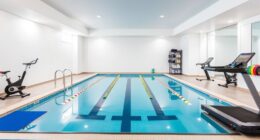Prehab in the pool helps you strengthen muscles and boost stability with low-impact, resistance-based exercises. Water’s natural resistance and buoyancy allow you to target muscles effectively while reducing joint stress. This environment improves proprioception and movement control, making it easier to prevent injuries before they happen. By adjusting water depth and movement speed, you can customize your workouts for progress and recovery. Keep exploring to discover how pool prehab can support your injury prevention journey.
Key Takeaways
- Water resistance provides low-impact, joint-friendly exercise, reducing injury risk during prehabilitation routines.
- Engaging stabilizing muscles in water improves joint alignment and supports injury prevention.
- Buoyancy and controlled movements enhance proprioception and movement control, aiding muscle coordination.
- Resistance adjustments allow progressive strengthening tailored to individual recovery needs.
- Pool prehab promotes muscle endurance, stabilization, and mental well-being, fostering long-term injury prevention.

If you’re looking to prevent injuries and improve your recovery, incorporating prehab exercises in the pool can be highly effective. The water’s natural resistance provides a unique way to strengthen muscles without putting excessive strain on your joints. Unlike traditional land-based workouts, water resistance offers a low-impact exercise environment that minimizes the risk of overuse injuries, making it ideal for prehab routines. When you perform movements in the pool, the water slows down your motions slightly and provides constant resistance, which helps target specific muscles more effectively while reducing the stress on your body.
Using water resistance allows you to engage stabilizing muscles that often go unnoticed during land workouts. These muscles are essential for maintaining proper joint alignment and preventing injuries. As you move through water, every step, arm lift, or leg kick works against resistance, encouraging muscle activation and endurance building. Since water supports your body, you can perform a wide variety of exercises safely, even if you’re dealing with previous injuries or recovering from surgery. This supportive environment helps you regain strength gradually without risking setbacks.
Prehab exercises in the pool also improve your proprioception—your body’s ability to sense its position and movement—which is critical for injury prevention. Water’s buoyancy reduces the impact on your joints, allowing you to focus on correct form and controlled movements. This low-impact nature is especially beneficial if you’re recovering from an injury or want to avoid aggravating existing issues. For example, simple leg lifts or arm circles performed in water challenge your muscles while keeping the impact minimal, making them accessible for nearly everyone. Additionally, incorporating resistance training in the water can help you progressively increase the intensity of your exercises as your strength improves.
Furthermore, water’s resistance can be easily modulated by adjusting your speed or the depth of immersion, giving you control over the intensity of your workout. You can start with gentle movements and gradually increase the difficulty as your strength improves. This flexibility makes pool prehab exercises adaptable to your specific needs, whether you’re warming up, rehabbing, or building overall resilience. The calming effect of water also helps you stay focused and relaxed during your routine, encouraging consistency and long-term benefits.
Frequently Asked Questions
How Often Should I Perform Pool Prehab Exercises?
You might wonder how often you should do pool prehab exercises. Following frequency guidelines, aim for 2-3 sessions per week to see benefits without overtraining. Consistency is key, so sticking to this routine helps strengthen muscles and prevent injuries effectively. Adjust based on your progress and how your body feels, but maintaining regularity guarantees you get the most out of your prehab efforts.
Can Prehab Exercises Replace Traditional Strength Training?
Think of prehab exercises like a car’s routine check-up—vital, but not a full overhaul. While they improve muscle flexibility and help injury rehabilitation, they shouldn’t replace traditional strength training. Prehab strengthens muscles in specific ways, but thorough strength training builds overall power. Combining both ensures you’re well-prepared and resilient, much like a well-maintained vehicle ready for any journey.
Are There Specific Prehab Routines for Different Swimming Styles?
You might wonder if there are prehab routines tailored to your swim stroke. Yes, specific routines focus on swim stroke specificity and muscle targeting, helping strengthen the muscles used most in your style. For example, freestyle prehab may emphasize shoulder stability, while butterfly routines target core and back muscles. Customizing these exercises guarantees you build strength relevant to your swim stroke, reducing injury risk and boosting performance effectively.
What Equipment Is Essential for Pool-Based Prehab?
When you focus on pool-based prehab, essential equipment includes aquatic therapy tools like resistance bands, foam noodles, and kickboards. These support your swimming pool maintenance and help implement aquatic therapy techniques effectively. Using these tools, you can target specific muscle groups, improve flexibility, and prevent injuries. Make sure your pool environment is safe and clean, allowing you to maximize the benefits of your prehab routines.
How Soon Can I Expect Injury Prevention Benefits?
You’re asking how soon you’ll see injury prevention benefits, and honestly, it’s a bit of a waiting game. While the injury reduction timeline varies based on your consistency and effort, many notice improvements within a few weeks. Keep at it, and you’ll find your muscles stronger and more resilient sooner than you think. Patience is key; results often come when you least expect them, turning your efforts into lasting protection.
Conclusion
By incorporating prehab in the pool into your routine, you’re not just strengthening muscles—you’re building a fortress against injury. Think of it as planting seeds today for a healthier tomorrow. With each splash and stretch, you’re turning vulnerability into resilience. So plunge in with confidence, knowing that every movement is a step toward a stronger, injury-free you. Remember, the pool isn’t just a place to exercise—it’s your personal safeguard for lasting strength.









